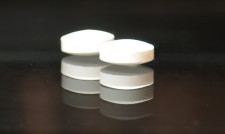
|
book reviews
medicinal chemistry booksreviewed by T. J. Nelson |

|
book reviews
medicinal chemistry booksreviewed by T. J. Nelson |

 f I were cynical, I'd say that pharmacology is the science of
understanding how to create better molecules while having as little understanding
as possible about the underlying disease. I'd probably also say that biologists
pride themselves in knowing as little as possible about the sordid business of
developing drugs, and that therefore the marriage between biologists and
pharmacologists has been a happy one.
f I were cynical, I'd say that pharmacology is the science of
understanding how to create better molecules while having as little understanding
as possible about the underlying disease. I'd probably also say that biologists
pride themselves in knowing as little as possible about the sordid business of
developing drugs, and that therefore the marriage between biologists and
pharmacologists has been a happy one.
Luckily, I'm not cynical at all, hardly, even though I might have good reason to be. Only one in 10,000 new compounds makes it to market. Only 11% of drugs that enter clinical development survive, and 70% of drugs that do make it to market never pay back the costs of development. If you're an industrial medicinal chemist that's gotta suck.
The new paradigm in industry is the ‘systematic’ approach to drug discovery, where every conceivable molecule is mindlessly tested. The goal is to reduce the cost of the 99.99% of drugs that bomb out by giving synthetic chemists an idea of where to start. It won't save money if you pick the wrong target. But at least it will streamline the process of throwing shit against the wall and hoping some of it sticks.
Once the high-throughput guys find their new mycoxafloppin candidate, it goes to the chemists whose job is to turn it into a drug that remains intact long enough to get to the target site and stays there long enough to do something, preferably without killing the patient. Thus we get to the cynic's description of the science of ADMET (absorption, distribution, metabolism, excretion and toxicity): how to create shit that has a higher affinity for the wall.
The authors recommend doing that with isosteres: functional groups that look the same to the receptor, but avoid metabolic activation, like fluorine instead of hydroxyl or tetrazole instead of carboxylic acids.
Sometimes this approach has miraculous results. DuPont chemists modified a chloroimidazole nonpeptide angiotensin receptor antagonist by adding a second carboxylic acid group, which reduced its IC50 from 40 to 1.2 μM. Replacement of the carboxylic acid with a 5-substituted-1H-tetrazole, along with a few other tweaks, resulted in losartan, which had an IC50 of 0.005 μM—an 8,000-fold improvement in potency.
The focus is exclusively on small molecules. The chapters cover carboxylic acids, amines, sulfonamides, aromatics, alcohols, and peptidomimetics. It's a typical medicinal chemistry book, suitable as an advanced text, but organized by functional group instead of medical use. There's a mixture of stuff that's review for most readers, like glucuronidation and P450, and lots of new stuff, with specific drugs used as examples. There's no synthetic chemistry, but there are many tables depicting structure-activity relationships, and chemical structures depicting metabolic pathways and drug development schemes. A background in biochemistry and pharmacology is recommended.
There are lots of new things for medicinal chemists to worry about these days. Many new drug interaction mechanisms have been discovered, and new understanding, learned the hard way, of how a prescription drug meant to save a life can unexpectedly kill a patient. Some patients have drug histories or genetic polymorphisms that radically change the toxicity of a drug. A very small minority of patients have mutant hERG channels, which has caused life-threatening arrhythmias from drugs that were long thought safe. If you're in pharma, knowing the stuff in this book is not optional.
nov 23 2014